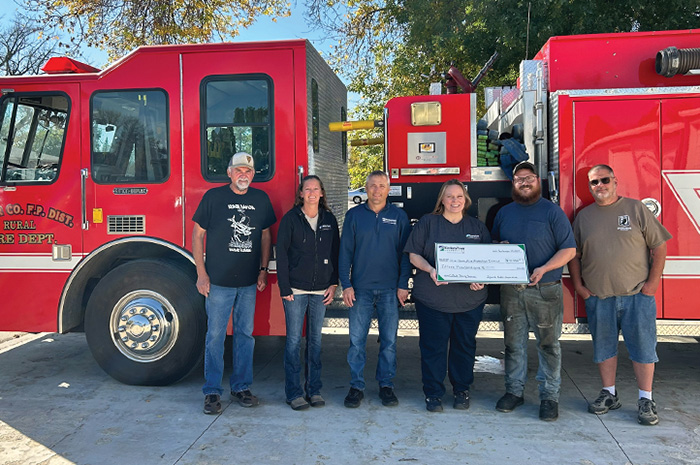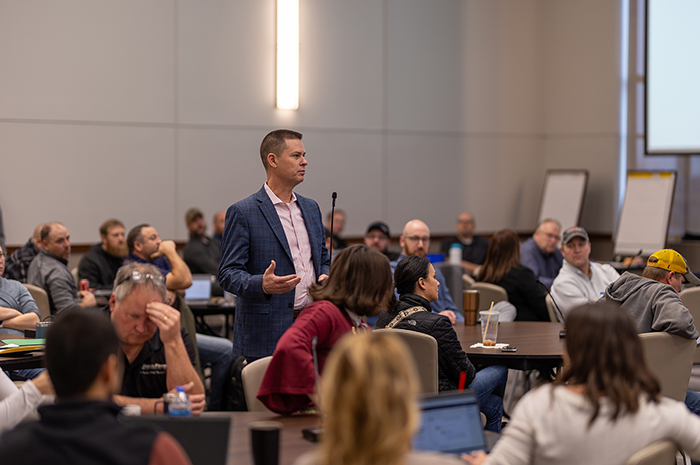One flight, endless opportunity
Minnkota Power Cooperative is reaching new heights with its LiDAR-based survey program.
Just after lunch on an 85-degree wind-free Tuesday, Seth Simonson found himself in a Park River, N.D. pasture, wiping sweat from his eyes so he could more deftly hopscotch his way around cow pies.
Surprisingly, it wasn’t new territory for the vice president and chief operating officer of Precise Sensing, a drone services company out of Fergus Falls, Minn.
“I have been chased before. When you have a big bull hoofing the ground…,” he trailed off with a smile.

Simonson was in the process of laying bright orange circles to help calibrate the GPS of his unmanned aerial vehicle (UAV). The DJI M600 Pro drone would fly a LiDAR survey flight over nearly 6 miles of Minnkota 69-kilovolt (kV) power lines that afternoon – one small data-gathering project of many the cooperative has planned with the technology.
LiDAR (Light Detection and Ranging) has emerged as a staple survey method for several industries that need a fast, accurate and (increasingly) cost-effective way to collect detailed information about large land areas and unique structures. Simonson says next to engineering and development, the energy industry is his largest LiDAR client base.
“When it’s in the air, the LiDAR is just spinning, sending out a bunch of different lasers,” Simonson explained as the LiDAR payload on his drone began to whirl pre-takeoff. “Those lasers will hit and collect 600-700 thousand points a second. Each laser has its own frequency, so the unit will count how long it takes for the laser to hit the ground and come back.”
The technology then uses a speed-of-light formula to determine the distance from the origin to the ground or item the laser hit, while also differentiating if that hit was land, water, a power pole, a building, etc.
“The amount of information captured in a LiDAR flight is overwhelming sometimes. You honestly have to filter out some points,” said Skylar Ertman, Minnkota civil engineer for power delivery. “But to have a 3D model of where things are at just that moment – that’s invaluable. It makes you feel confident about any product you’re designing.”
Ertman helped coordinate this drone survey to more accurately assess and design a rebuild of the Mandt-Park River line planned for 2021. It’s a small side project of a vigorous LiDAR program Minnkota started in 2019. The program will use a mixture of manned and UAV LiDAR surveys to gather information useful for many areas, including transmission planning, system operations and North American Electric Reliability Corporation (NERC) standards compliance.

Vital for vegetation
One impetus behind Minnkota’s most recent LiDAR initiative was the vegetation management program’s search for a better way to identify and manage tree trimming work areas.
“LiDAR is an extremely precise surveying tool that is used to collect data points as to ‘where in space’ our transmission structures and conductor are,” explained Brenden LaHaise, Minnkota engineer and vegetation management program lead. “It also detects a variety of other data points, vegetation being one of them.”
Minnkota civil engineering manager Wayne Lembke added that his team is able to easily provide vegetation management with information about maximum conductor sag and blowout on lines that have LiDAR and PLS-CADD (Power Line Systems computer-aided design and draft) models available.
“We can look at a specific span and identify if a tree needs to be removed,” he said. “After the initial LiDAR flight and modeling, we can collect vegetation-only LiDAR. We can compare the previous model to the new data and determine vegetation growth or removals that have been completed.”
Drone precision
The precision of drone-based LiDAR flights has gone well beyond Minnkota’s first manned LiDAR survey back in 2007, when a plane flew the Center-Heskett 230-kV line. Planes must speed over lines and can collect only a few data points in that time. Drones fly slow enough that they can pick up millions of data points, even capturing swinging lines.

During just the first 1,000 feet of Simonson’s flight of the Mandt-Park River line, he gathered 30 million points of LiDAR data. Ertman says a ground survey of that same distance would return only 100 points.
“You want to know how close that tree is to that line? Well, from which leaf do you want to know?” Simonson joked as data started to roll into his laptop.
Ertman looked over the drone pilot’s shoulder to see millions of points forming a 3D cloud of poles, conductor and land. “It’s pretty fulfilling when you get stuff like that,” he said.

Minnkota engineers receive raw LiDAR data in an XYZ-formatted spreadsheet that uses “feature codes” to determine what each point represents along the line’s corridor – 150 feet wide. The engineer brings that data into design software and assigns symbols using those feature codes. The corridor then appears in brilliant 3D, packed with useable, interactive information.
“The benefits are almost endless,” Ertman said. “On the engineering front, it’s so valuable to us, because we get such a deeply detailed description of what the line corridor looks like. We don’t have to assume.”
Ertman says the use of LiDAR surveys has given him an extra layer of assurance in his designs, as he knows nothing in the corridor will be missed, like a steep riverbank or crossing conductors. “You get ditch bottoms to top of grade on a highway. You know your survey is going to be spot-on,” he said.



Future flight
In the past several years, Minnkota has found several ways to innovatively integrate drones into its planning – to increase inspection and survey accuracy, but also to help research the opportunities of the technology. LiDAR has grown into the most valuable of those opportunities, and Ertman believes this is only the beginning of its rise in the industry.
“It’s already a standard. If line-of-sight regulations improve, or they figure out more ways to be even more cost-effective with a UAV, it will blow up more than it already has,” he said.
As LiDAR costs decrease, Minnkota will look to incorporate flights even earlier in its planning stages. That proactivity will help the cooperative save money and resources down the road and better plan for the future.
“I see Minnkota continuing to use LiDAR to help prioritize our transmission line rebuild projects,” Lembke said. “I also could see using LiDAR to create 3D models of existing substations that may require modifications or expansions.”
And for drone pilots like Simonson, the future of LiDAR is worth any obstacle – bovine-based or otherwise – thrown their way. “I enjoy the technology,” he said. “It’s something that not everyone is doing, and it brings a sense of accomplishment.”
Main image: A LiDAR-equipped drone hovers near the Park River substation. (Minnkota/Kaylee Cusack)
...



